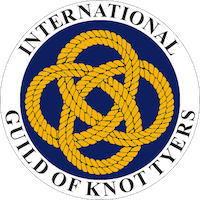The UK Sea Cadet Corps requires that all candidates for promotion must have a basic grounding in seamanship. These knots are the basic requirement (Seamanship Third Class). A cadet pursuing a Seamanship Specialisation needs to know more.
For more general information about the Sea Cadets, please visit Southern Sea Cadets Facebook page or visit the Sea Cadets primary website.
This page shows each knot and gives a brief note on the way the knot is made and its application on ships. The diagrams show the knots tied loosely so that their construction is clear.
Overhand Knot
 Used to start the racking of a hawser
Used to start the racking of a hawser
Figure of Eight Knot
 For stopping a rope unreeving through a block or to temporarily stop a rope from fraying.
For stopping a rope unreeving through a block or to temporarily stop a rope from fraying.
Reef Knot

- Comprises two successive overhand knots.
- To secure furled canvas (because of the ease with which it may be spilled). Also used for finishing off the racking on a turned up hawser.
- WARNING: The reef knot should never be used as a bend to join two ropes that will be under load.
Round Turn and two Half Hitches

- A round turn made round the spar and two half hitches made round the standing part of the line.
- Securing the head rope of a ship's boat to the ring of a buoy.
- A very useful general purpose hitch to a spar or ring.
Rolling Hitch

- Two round turns and one half hitch made round the spar.
- Securing ropes that have lateral pull e.g. heaving line to the picking up rope, gun line on the messenger when returning gear after a refuelling at sea (RAS), fastening a line to a spar.
Clove Hitch

- Two similar half hitches put round the object to which it is to make fast.
- Securing items that hang vertically, e.g. paint kettles/ fenders attached to guardrail stanchions, fastening a rope to a spar, securing ratlines to the shrouds.
Sheet Bend

- Pass the end of one rope through the bight of a second rope, around both parts of the bight, and under its own standing part.
- Securing the boat's painter to the Jacob's Ladder on a boom, for joining two ropes the same or similar sizes, in bending small sheets to the clews of sails, in bending flags to halyards where snap hooks are not fitted.
Double Sheet Bend

- Pass the end of the bending line through the bight of the standing line, twice around it and through its own part, giving added security.
- For securing the boat's painter to the lizard on a boom, joining ropes together when they are not too large, especially when they are of different sizes.
Timber Hitch

- Make a turn around a spar, around the standing part, and then several around its own part.
- Add an additional half turn round the spar when the pull on the spar is lateral.
- A quick way of securing a rope temporarily around a spar or timber. Much used in handling cargo.
Bowline

- Pass the end through a loop on the standing part, round the standing part and back through the loop.
- Securing the heaving line to the eye of the hawser, for tying around a person's waist whilst using a lifeline, e.g. when aloft, or when making a temporary eye in a rope.
- It does not slip or jam and can be cast loose instantly, as the tension is released
Fisherman's Bend

- Take a round turn with the end coming under the standing part under both turns, withtwo half hitches on the standing part. For security the end should be seized.
- Securing a boat's anchor cable to the anchor, making a buoyrope fast to a buoy .The greater the pull on the rope, the more tightly the parts of the bend are jammed against the anchor ring.
Heaving Line Knot
 Provides a temporary weight to the end of a heaving line, as a quick alternative to the Monkey's Fist.
Provides a temporary weight to the end of a heaving line, as a quick alternative to the Monkey's Fist.

